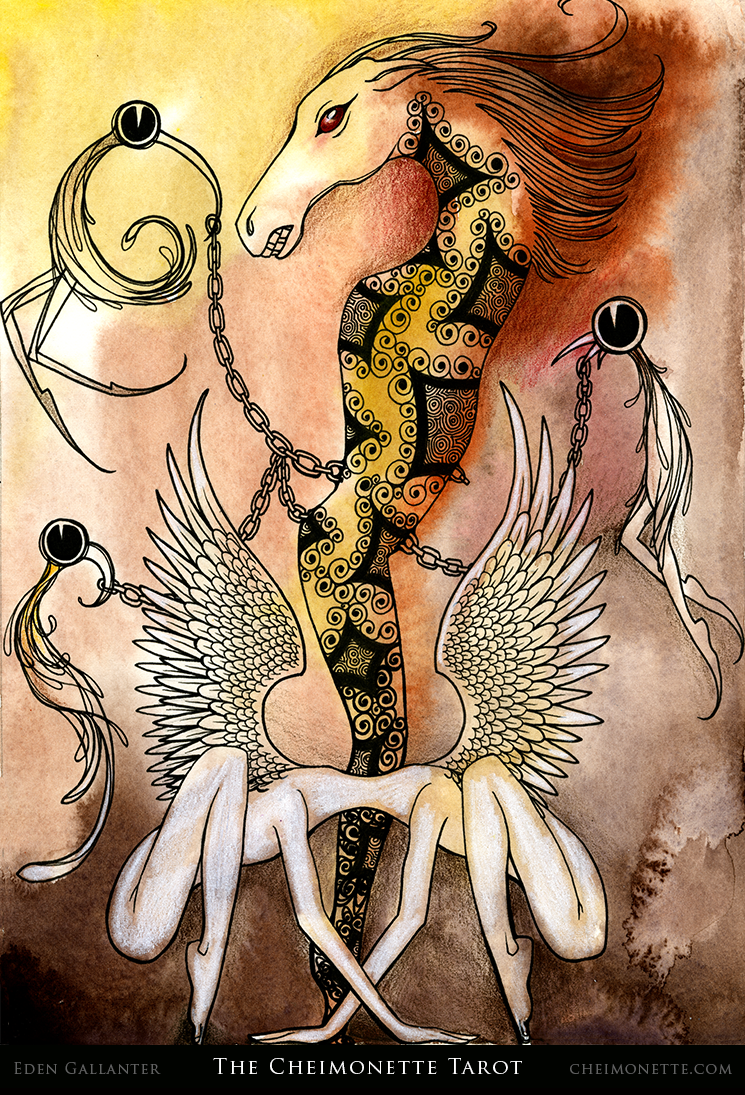The Dizziness of Freedom: Fortitude and The Devil
“Anxiety may be compared with dizziness. He whose eye happens to look down into the yawning abyss becomes dizzy. But what is the reason for this? It is just as much in his own eyes as in the abyss . . . Hence, anxiety is the dizziness of freedom.” -Søren Kierkegaard, The Concept of Anxiety
The Cheimonette Tarot has several unique connections between the cards, and I wanted to expand on one of them, the Fortitude (Strength) card, and The Devil, embodying opposite and contradictory concepts of freedom and captivity.
Free will is a funny concept, wherein we are told (at least, by the Judeo-Christian bible) to think of that which we take for granted as a special dispensation from god, conferred on human beings alone. Otherwise, those who believe in a deterministic universe may argue that, in the inexorable course of time, the world is constrained to have only one sequence of events, only one outcome, only one choice. Within this miasma of divine boredom (god sits on his couch, having ruined the movie for himself, watching the story play out without any hope of astonishment), free will gets lost in the shuffle, crushed under the bulk of an all-powerful fate.
In Fortitude, a blindfolded woman is frozen in the moment just before she leaps off the back of a speeding, headless, horse. Is she in danger? The scene would suggest not. Sprouting from her back are four insect wings, poised to go into action at any moment. In fact, the woman seems to be about to fly, rather than to fall. There are in fact three blindfolded characters in the Cheimonette Tarot (and none of them are the blindfolded Fool of the Rider-Waite Smith tarot deck): the Priest, the Ace of Swords, and Fortitude. Each of these cards represents a different act of courage, and the latter two symbolize a genuine leap of faith. True strength is not about confidence, but is an act of imagination. After all, the strong must accept that they are in danger. When we travel as far as the legs of human experience: wisdom, reason, and animal instinct (the headless horse), can possibly carry us, we may take an imaginative leap, and thereafter decide for ourselves the course of our lives.
If fate denies free will, this leap is nothing more than another foreordained act of human limitation, but if fate accepts free will as a cohabitant and a sister, then machinations of a deterministic universe affect our freedom not one whit. What have the affairs of the gods to do with our mortal choices? Our mortality make us artists, generating beauty, wonder, and nonsense within the monotony of omniscience.
In the Devil, we find the head of the galloping horse in Fortitude. Although Fortitude's horse, despite having no head, has a seeing eye where its head would be, the animal's mind and mouth and face are missing. In the Devil, the horse's head expresses pain and fear, seemingly unable to move its limbless body even without the superfluity of the chains, held by unwinged, birdlike creatures. There are no people in the Devil, although the angel, itself headless as it merges in terror back into itself, spreads its wings as a sign of its power to escape. The Devil horse portrays human suffering. The nameless birdthings (the identity of which is as mysterious to the author as it is to you, reader) have no expression, either of satisfaction or dismay or confusion. The expressions of their faces remain illegible. A scene to make the angels hide: the disenfranchisement of the soul from its birthright of freedom and fortitude.
Anxiety is a natural reaction to danger. The abyss, as everyone knows, can be frightening and disorienting in its hugeness. There is nothing really left to do, then, besides tie on a blindfold and jump, and fly, or else stay in your shackled little world forever.
This post is part of a series about my deck, the Cheimonette Tarot.

